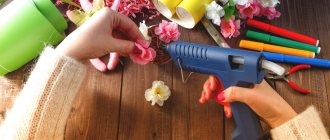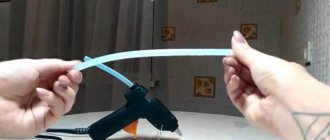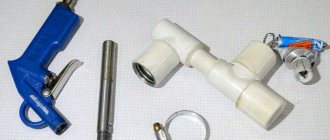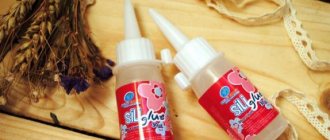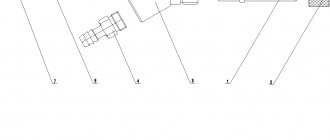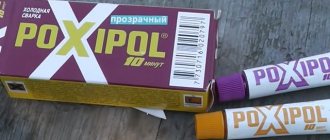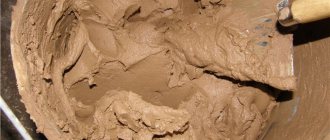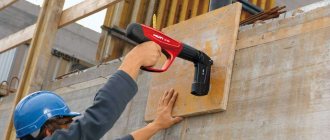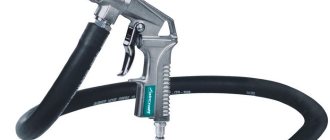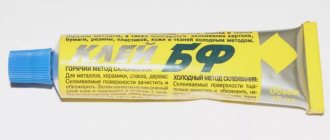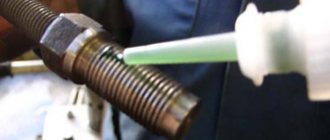Carefully! Electric current | 09/01/2016
Today, we will look at a tool capable of gluing together various materials; it is used in many sectors of the national economy. The hot glue gun has gained popularity among many craftsmen due to its fairly simple design, ease of use and low cost of consumables. With the help of such a tool it is convenient to solve not only practical problems, but also to use it in the field of interior design.
About glue sticks or sticks - what they are and how to use them without guns
A glue stick is a cylindrical oblong stick, which today is sold not only in specialized stores.
These sticks consist of an adhesive composition, but in order to prevent them from sticking together prematurely, they contain a hardener. This hardener loses its properties when exposed to high temperatures, which is very convenient to use. The rods have different lengths, thicknesses and even colors, which is done specifically so that everyone can choose the necessary material depending on the technological task. First, let's figure out what colors glue sticks are and what materials they are used for:
- Transparent - the most popular, allowing you to glue glass, metal, tiles, paper, etc. Their main advantage is that after use, they leave virtually no traces. Transparent sticks are popular for needlework
- White - used for connecting plastic, cables, tiles, tiles and other white products
- Black - used for bonding leather and carpeting
- Yellow - allows you to glue wood, cardboard, paper, and other similar materials
In addition to standard colors, there are also sticks consisting of several colors or with glitter. They are usually used for drawing various figures when making crafts. If the tool is used only for gluing around the house, then ordinary transparent rods will do, but for needlework you will have to stock up on sticks of different colors.
The length of the glue sticks affects how long the tool will last. If you do handicrafts or glue linoleum, then it is recommended to choose long rods. In cases where you need to glue or grease, it is better to buy short rods. Manufacturers produce them in lengths from 40 mm to 200 mm. The shorter the rod, the more often you have to install new ones, which is inconvenient, for example, when making crafts.
When purchasing, the seller will ask a question about what diameter of the rods are needed? All household appliances have a mounting hole of 7 mm, and professional ones have 7 mm and 11 mm. There are others, for example 9 mm, 12 mm, but they are rare. Typically, the diameter of the rods that can be installed in a specific device model is indicated in the instructions. It is impossible to install a rod with a diameter of 7 mm into an 11 mm hole, since the pusher will not be able to push it forward.
This is interesting!
Manufacturers produce tools with different hole sizes for installing glue sticks.
Thermal guns of 7 mm and 11 mm are popular, which must be taken into account when purchasing consumables. https://youtube.com/watch?v=GkhqJFtFjsU%3F
What sticks
Thermoplastic rubber-like mass easily glues materials of different structure and origin. Paper, wood, cardboard, glass or rubber - all of them can be done with a glue gun.
Paper
Instant and effective gluing of paper using a quick-hardening compound is not a problem. Attaching a sticker, creating an airy openwork composition or a regular envelope with a heat gun in your hands is much easier than using other methods.
Cardboard
Cardboard, as a denser material, is more difficult to glue with conventional mixtures than paper. But using hot glue is easy. The seam is durable, waterproof, and can withstand loads. A significant advantage of the technology is that you do not have to wait for the solvent to evaporate (the glue dries). This significantly speeds up the assembly process.
Ceramics
Apply a layer of glue to one half of the broken cup, then to the other, wait 15 minutes. You can forget about this technique forever if you have a glue gun on your farm. Wait until it warms up, drop or strip hot melt glue onto the contact areas, press firmly - and the product is as good as new.
Tree
The high adhesion of the plastic mass allows you to easily connect wood together and attach bars to other materials. Before work, you need to make sure that the surface is cleaned of dirt and dust, dried, and degreased.
Styrofoam
Polystyrene foam is a hard-to-glue material and requires the use of special compounds. This does not apply to hot melt equipment. We load the rod into the gun, turn it on, and pull the trigger. Next we glue at least the ceiling tiles, even the baguettes. It sets instantly.
Glass
Another problematic substance for which it is difficult to create a strong seam. Connecting glass parts to each other, repairing a crack, or attaching a plate to another material without a glue gun is not only difficult, but sometimes impossible.
See also
Requirements for nail glue, review of the best manufacturers and how to use
Rubber
Quickly gluing rubber without using special technologies and without waiting several hours until the seam gains strength - this was impossible to think about before. Melted glue from an electric gun solves the problem in an instant.
Metal
Ferrous and non-ferrous metals have always been difficult to glue. For this purpose, synthetic mixtures and epoxy compounds are used, which have the greatest joint strength. But the gluing time is also considerable. Using a gun with a set of rods saves effort, time, and nerves.
Problems and their solutions
The most common problem when working with a heat gun is that the glue flows uncontrollably, without pressing the trigger. There may be several reasons:
- The temperature is too high for a particular rod. It is optimal when the heat gun has a heating regulator to set the required melting degrees. Otherwise you will have to replace the rods. In a good gun, the nozzle has a ball valve - the so-called drip protection;
- The rod is inserted too tightly. Sometimes it helps to move it back a little;
- rod diameter mismatch. Some models require decimal sizes. For example, Sigma - 11.2 mm. If you put an 11 mm rod into such a device, a pressure difference occurs inside the heater, and the glue flows back. Using rods of the correct diameter solves the issue;
- low quality pistol. You can insert a toothpick into the nozzle during a pause in work. Or accept it and try to finish the work as quickly as possible: the contents flow out very quickly.
If the glue stops coming out, the gun may be clogged. It is disassembled and cleaned. To avoid this, do not allow glue to stick around the nozzle.
You can get excellent results and joy from work only with a working hot glue gun
For battery-powered models, the glue sometimes becomes viscous and has difficulty passing through the nozzle. You need to reheat the device in the charging station.
In cheap models, when there is a break in use for several minutes, the pusher gets stuck in the soft rod and cannot move it. You need to turn off the gun and let it cool.
If the glue stretches like a thread and you can’t apply a dot, craftswomen advise keeping the rods in the refrigerator. Most likely they are of low quality.
How to change the color of the rod correctly
To prime the gun, the rod is simply inserted into a special hole at the back. After finishing work, you don’t have to remove it. Then the next time you turn on the device will be immediately ready for use.
Sometimes it is necessary to change the color of the coming out glue, for example, blue to transparent
If the gun has cooled down, turn it on for about 1 minute, then carefully unscrew the rod. Charge the new one, press the trigger to squeeze out the remnants of the old one until the desired color appears
The new rod, after insertion, by smoothly pressing the trigger, completely pushes out the remnants of the old one
Safety precautions when operating the device
When working, do not forget about safety, the device operates from the mains, and high temperatures are also used, so the operating standards are observed:
- Study the instructions for the device, which states how long the gun can be used without interruption;
- Do not turn on the device without hot glue;
- The cable must always be placed at the rear of the device;
- The tip of the nozzle and the adhesives themselves become very hot during operation; they should not be touched during this period;
- Working in wet conditions is prohibited; hands should not be wet either;
- During operation, the glue is placed on a stand; it is not installed horizontally, otherwise the melted glue will damage the equipment.
The tip of the nozzle and the adhesives themselves become very hot during operation; they should not be touched during this period.
What is a glue gun used for?
What is a glue gun used for and what does it glue? It's easier to say what he doesn't like. Using this small and convenient device, joints are sealed and installation seams are filled. It allows you to speed up the installation of ventilation in the garage and ensures quick installation of sound insulation. It makes it easy to glue up loose wallpaper or a curved baseboard on the ceiling or in a hard-to-reach corner. A stick-on gun will quickly and easily attach ceiling moldings or wall appliques.
Many types of force majeure repairs are carried out using softened and carefully dosed glue, including gluing up a decorative plaster stone that accidentally flew off - do not dilute a bucket of mortar just for the sake of one bounced tile. Designers and radio amateurs resort to the adhesive tool; it is useful for modeling and design. There are craftsmen who are able to add design advantages to the adhesive mass itself, placing it in balls, elongated beads or colorful rain on walls, panels, postcards and souvenirs. So the capabilities of such pistols are not limited to repairs.
Photo of glue gun, e-ukrservice.com
Pictured is a glue gun, e-ukrservice.com
Photo of a cordless glue gun, e-ukrservice.com
Photo - what can be glued with a glue gun, e-ukrservice.com
Photo - how to choose a glue gun, e-ukrservice.com
Purpose
Glue guns are intended for decorative, installation, and professional work. There are even devices for straightening car body parts: using heavy-duty glue, they pull out dents in the sheet skin. There cannot be universal pistols. You need to immediately decide where the hot-melt adhesive unit will be used, and only then move on to the choice.
Decor
Gluing guns have long been used to create decorative panels and compositions to quickly and reliably attach parts to a base, surface made of wood or metal.
Repair
Another area in which glue guns have found application. To glue tiles to the floor, fix a suspended ceiling, or fix a wooden block to a stone wall, it is not necessary to use standard methods. 5 minutes of work with the gun - and the part is in place.
Needlework
A strip of glue from a gun glues fabric, thread products, knitting, and connects embroidered pictures to the base. The polymer mass replaces conventional synthetic adhesives, and surpasses them in strength and speed of hardening of the seam.
Construction
Fastening carpet, installing electrical fittings, securely fixing plumbing fixtures - and a glue gun will help with this. Polymer rods have high adhesion to any surface. You just need to clean them from dust, degrease and dry.
Warehouses and movers
The device is suitable for temporary fastening of structures in a warehouse, creating an instant connection between plastic and metal, wood and glass. One powerful gun is enough to apply glue in a small warehouse. You can fix parts pointwise, in stripes, along a contour - there are enough options for a solution. It’s also convenient to use colored rods to mark goods, creating a strip of glue in the required place.
Life
Repair broken dishes, glue tiles, flooring, fix the tabletop. To do this, you do not need to keep several different synthetic adhesives on hand.
Plastic and PVC models
And with the help of molten glue you can quickly and reliably fasten plastic parts together. But not all. There is a restriction on PVC; Hot glue cannot repair a torn shower curtain.
Fabrics
Such a complex and impractical material to glue as fabric, with rare exceptions, is successfully joined using a hot-melt gun. The choice of base and combination of fibers does not matter - for hot-melt adhesive they are all equivalent and are easily bonded.
Concrete, gypsum and similar materials
One of the few exceptions, white spots, for which a glue gun is not suitable. It will also not work to glue plaster or create a strong seam between the concrete surface and another structure (paper).
How to use
Thermal guns are used at large furniture manufacturing enterprises, where they are used to install finishing elements on cabinets, upholstery of sofas, and armchairs. They are used in construction and the production of decorative items. When purchasing for home use, the list of operations increases. Hobbies, children's crafts, interior decoration, minor repairs are the area of application for a glue gun. You need to know the rules for using the device at home. Additional information will make the gun more effective where it can be used, and put it aside where it is inappropriate.
How to charge
Manufacturers have tried to make the operation of the device simple. The design of the pistol allows it to be loaded without additional devices, disassembly, or other operations. The simplest charge is the first one. The rod inlet and nozzle are clean. There are no traces of past work, signs of physical impact, or damage. For work, take the glue of the required brand. When purchasing, you need to know the characteristics of the rod. Products include the following types:
- Transparent. Universal rods with low melting point.
- Black. Designed for sealing joints, like sealant. They have a high melting point.
- Colored. The polymer is painted over the entire mass and the glue on the parts is not visible. Widely used in handicrafts.
- Decorative. They are used when the glue itself becomes a finishing element. May contain glitter, mother-of-pearl, and fibers.
- High temperature. Special types of glue for fixing elements that are subject to increased loads.
As a rule, charging the glue gun itself is not difficult. The rod is inserted into the hole in the back of the device until it stops. In some models, it is necessary to advance it by repeatedly pressing the trigger until it rests on the heating chamber. Guns with a temperature indicator are convenient. A glowing diode indicates that the device continues to heat up. When the indicator goes out, you can start working.
Warm-up rules
The melting point is indicated on the packaging with the rods. If you purchased a low-power gun, then not every type of glue will work. There are models designed to work with low-temperature rods that melt at 105 °C. It is not recommended to insert consumables with a higher melting point into them. Even if the glue begins to soften, the work will be very difficult and long. Excessive pressure on the mechanical parts of the gun may cause them to break.
Depending on the power of the device and the quality of the glue, the heating time can be 2–8 minutes. If after this period it is not possible to squeeze out the molten polymer, then the gun does not fit the brand of the rod, or it is broken. Overheating also has negative consequences. Liquid glue may randomly flow out of the nozzle and enter the directional coupling, which will then require cleaning. When working with different brands of rods, you need to get a device with a temperature regulator. Then it will be easier to glue, using all available possibilities.
Replacing the rod
Inexperienced craftsmen often have problems when a small piece of consumable material remains. The rod leaves the feed mechanism, but partially remains in the guide sleeve and heating chamber. You can just push it through next. But it is much more convenient to drop hot glue onto the end of the new rod and connect it to the shank of the one already in the gun.
If a cold gun already has a rod that needs to be changed, you must first warm it up. The hardened polymer mass cannot be removed from the device. You can break it. The gun is plugged in and the rod is carefully removed, in place of which a new consumable is already installed.
If you haven't read the instructions
Basically, a glue gun is not a space shuttle or even a supercomputer. It is difficult to spoil it through unintentional actions. It is enough to act by trial and error, following the basic simple rules. And the process of mastering the glue craft begins with preparation.
Preparation
You bought (rented from friends) a glue gun. You don't know or have forgotten how to use it. First, remove the unit. To do this, the gun is removed from the blister (cheap and household models) or suitcase (professional). The set “gun + glue” should be formed. This involves installing the nozzle, selecting the rod and plugging it into the outlet. Autonomous models are charged until the battery is fully ready. For models with manual temperature control, the regulator is set to minimum. For those equipped with a toggle switch, you need to press the key, switching it to power supply mode. And only after this can we begin field testing.
Usage algorithm
The method of using a heat gun is simple to the point of primitiveness: wait for the set time for the rod to warm up, press the button, squeezing out a stream of glue, release, then press again. There is no need to press hard on the lever, trying to speed up the flow of not completely melted glue. Such impatience will result in the gun breaking.
By directing the nozzle and synchronously working with the rod pushing key, a layer of glue is formed on the part (the seam is filled). The length of the rod is not infinite, so at the same time they monitor the glue consumption, adding new cartridges in time. Sometimes the glue comes out with a characteristic pop, this is not a breakdown, just air. The rod should fit tightly into the grip, resting against the chamber. As it warms up, it is moved forward. Before changing the type of rod (by color, melting temperature), it is advisable to clean the nozzle.
To do this, the gun is allowed to cool, disassembled, and cleaned with a wire or pin. It is recommended to perform the same procedure when you stop working with the gun. The nozzle is the hottest part of the glue gun. On some models, the body becomes noticeably hot. On average, the temperature is 100-110 degrees, and the output is glue.
Usage time
The average time to use a glue gun is 30-40 minutes, depending on the model and individual features of the unit. The body and handle of different products do not heat up equally, this also affects the duration of operation. Another limiting factor is the length of the glue stick. Usually, after the glue cartridge runs out, it is recommended to clean the nozzle before installing a new one. This will be the operating time of the gun. In advanced designs, the heater does not remain constantly on. When idle, it automatically switches to stand-by mode to save energy and extend the life of the gun.
Hot glue gun: design and operating features
The shape of a glue gun is similar to a regular gun, which is why it got its name. The device is filled with a glue stick, which, when heated, melts to a fluid consistency. The rod must be installed from the back of the tool, tucking it into a special receiver. During operation, its tip enters the heating module, and in about 4-5 minutes the glue melts. When the trigger is pressed, the composition comes out of the nozzle onto the surface of the product.
The design of the glue gun includes the following elements:
- Heating module. Located in the barrel, it is a metal reservoir, at the bottom of which there is a heating unit. More expensive models have multiple heating units to melt the glue.
- Ring pusher. This is the glue supply mechanism that most often breaks, mainly due to excessive force by the user.
- Clutch. It looks like a tubular receiver located under the glue heating chamber. The coupling is needed to seal the system elements so that the molten composition does not get into them.
- Nozzle (nozzle, nozzle). Allows you to direct the flow of glue in the desired direction. There is a shut-off valve inside that prevents the solution from flowing out freely. The outside of the nozzle is coated with a heat-resistant alloy that protects it from damage. This part of the gun must be cleaned regularly to remove any glue residue.
Distinctive features of hot glue guns
When choosing, you need to pay attention to the quality of the hot glue gun body. The box itself must be made of durable polymers that can withstand heat without burning your hand
There are models with a viewing window where you can see the remaining glue. The handles often have anti-slip inserts, and the package includes a stand. An interesting design is the spray gun, which significantly speeds up the application of glue to large surfaces. When purchasing a gun, you must compare the diameter of its barrel with the size of the glue stick - they must match.
Required glue heating temperature
The glue begins to melt already at +80 degrees, but the process will be very slow. Therefore, guns make it possible to melt the material at +150…+200 degrees, which seriously increases productivity. In expensive professional models, the heating temperature of the glue reaches +500 degrees.
Glue feed speed
Typically glue guns can dispense 5-20g of glue per minute, although the rate depends on heating time and user need. The upper limit of the indicator, in fact, is the limit of the capabilities of both the device and the master, otherwise there is a high risk of making a mistake. However, special high-speed guns (30 g of glue per minute and above) are sold for professionals.
Key properties when choosing
The pistol is selected depending on the goals and tasks that it has to perform. For crafts, the most simple, low-power one will do. For repairs, a more serious unit will be needed. The same applies to the diameter of the working rods. The most popular is 11 mm. Smaller ones are less common, larger ones are used in industrial products.
It wouldn’t hurt to have a switch and a stand to secure the gun “at idle.” It heats up quickly, so the toggle switch does more good than harm. When choosing, you should not buy the cheapest, unsightly, poorly packaged pistols: they will not last long. It is better to give preference to legally manufactured products, with product details and a guarantee in case of breakdown.
Check valve reliability
The presence of a special device - a check valve - allows you to extend the life of the gun and get rid of unpleasant glue drips. Its reliability directly depends on the class of equipment and quality of manufacture, as well as handling of the device.
The check valve is a special ball that blocks the flow of glue in the nozzle. To increase the service life of the unit and the gun as a whole, it is necessary to periodically clean the internal channels of the frozen adhesive mass.
Glue heating time
This indicator is not the same for different models. It is related to power, the presence of a heating regulator, and the type of glue stick. On average, this is a period of up to 5 minutes. Industrial models, with a powerful heater and the function of changing the temperature of the melt, are ready to supply liquid glue faster than their smaller brothers. But the difference in price between them is considerable, and this also affects the choice of a housewife or a crafts maker of “Kulibin”.
Availability of attachments and extensions
Additional devices or additional parts always have a beneficial effect on the operation of the unit, since they expand the arsenal of its skills. In the case of a pistol, these are replaceable nozzles with different outlet diameters and special extensions. The benefits of them are undeniable: penetration into hard-to-reach places, regulation of the portion of glue squeezed out at the touch of a button. Simple models are usually not equipped with such accessories, only expensive and professional ones.
Rods
They differ in diameter (7 or 8 millimeters, 11, 25, and so on), melting point, color. Saving on normal rods for the sake of low-quality and cheap ones threatens uneven melting, the appearance of stretching “snot” and a decrease in the strength of the seam. Colored glue sticks are needed to create applications, three-dimensional figures, and fix some interior details.
Standard rods for all occasions are milky in color. They are used by 90% of pistol owners. Before purchasing consumables, you need to know what standard size a particular piece of equipment works with. The rod is not a pencil; trimming it and somehow inserting an 11 mm into an 8 mm pistol will not work.
Chamber size and heating element power
The hot glue gun is designed in such a way that the size of the heater, the “firebox” for heating the rod and the power correspond to the dimensions and class of the device. Small, 15-watt pistols have enough chamber to work with a 7-8 mm rod. Solid models are designed for a larger size, which means they will heat up a piece of glue faster and prepare it for work. This is pure physics, which also applies to glue guns.
See also
Characteristics and types of cork glue, instructions for use
Wire length
It would seem that this parameter is insignificant in comparison with others. But it is inconvenient to work with a “short-wire” gun: you need to be directly close to the outlet. The issue is solved by connecting an extension cord, but why do this if you can purchase a gun with a longer power cord?
Availability of replaceable nozzles
Another bonus that will be appreciated by those who plan to use a glue gun a lot and often. The nozzle is clogged, there is no time or desire to clean it - a spare tire will help. It also happens that the nozzle is hopelessly damaged, clogged with glue, and the working unit is needed urgently - changing the nozzle will also help. The total service life of the gun depends specifically on the condition of this unit (not counting the heater).
Power regulator
The presence of a function for controlling the melting temperature of the rod will be appreciated by those who do not have it on their pistol. It will melt everything at the same rate, regardless of the type of plastic charged. And an advanced gun with speed control is convenient because it allows you to save energy and vary the modes in relation to the characteristics of the glue stick.
Nozzle type
Most guns are equipped with standard light alloy nozzles coated with silicone. Options with different spout lengths are available to ensure ease of use for superficial and deep application of glue. The working diameter of the rod corresponds to a certain passage value for the glue in the nozzle, as well as the dimensions and standard thread size for mounting on the gun. It will not be possible to place a nozzle from a “small” unit on a “large” one. In the simplest models of pistols, the spouts are made non-removable and connected to the heating chamber.
How to use: charge, warm up, replace the rod
The small device is made using modern technology and is very easy to use. To avoid interruptions in work, the points for applying glue are planned in advance and all the necessary materials are prepared. The viscous mass cools quickly, especially in low-power models. The sooner you apply little things like beads, rhinestones or sequins, the stronger they hold on. The operating procedure is as follows:
- Connect the device to the network. If there is a power button, put it in operating mode.
- Insert the rod into the special rear hole until it stops. Leave to heat for the time specified in the instructions, ranging from 2-10 minutes. The plastic body of the heat gun also gets hot. By touching it, you can check the operating status of the device if there is no power indicator.
- Press the feed control button. A drop of hot substance will appear - the device is ready for use.
- Apply glue to one of the parts and immediately press the surfaces to be glued together. Can be applied spotwise or in a stream. The glue releases as long as the trigger is pulled.
- If any remaining glue appears, remove it with a sharp knife after cooling. The hardening area can withstand mechanical loads after 5 minutes.
During a break in work, the gun is placed on a stand. The nozzle should point downwards; it is advisable to place some kind of substrate under it. Silicone is better because the glue does not stick to it. Then no hot residue will get onto the work surface.
A special stand for the heat gun protects the working surface from hot drops and fixes the device
In the window of the gun you can see when the rod ends. To continue work, insert the next one, which will push through the remains of the old one.
Bonding points can be separated by heating.
Features of choosing a tool
A tool is usually purchased with the intention of using it for a long time, so it is important to choose an option that is convenient for you. The following parameters need to be taken into account:
- The presence of a battery will make it possible to work anywhere without being tied to the mains;
- Type of rod feeding mechanism, there is a slider and carousel version. The second one is less comfortable because you need to turn the handle and not press it, as in the first type;
- The number of heating elements, if there are several of them, then this is better. They will replace each other during operation, but the cost will also be higher.
The presence of a battery will make it possible to work anywhere without being tied to the mains.
Hot glue crafts
What can be made from hot glue? There are many ideas for crafts for beginners on the Internet (for example, on the YouTube channel Trum-Trum-Select), life hacks and interesting interior items are described. To work you will need:
- glue gun;
- foil;
- translucent paper;
- pencil;
- wax crayons;
- cardboard;
- acrylic paints;
- sparkles, etc.
You can use hot glue to decorate your phone case. The product is squeezed onto the product in the form of any pattern you like, allowed to dry, and then carefully painted with acrylic paint. You can also pour glue into a silicone mold and insert a metal ring on top. After hardening, you need to remove the mold - you will get an original keychain.
It's easy to fill your fangs with a gun for Halloween. To do this, you need to lubricate the foil with regular hand cream, then squeeze the teeth blanks directly onto the cream. After hardening, they can be removed, painted and glued to a cardboard mask. Using hot glue, you can draw on fabric, wool, paper and wallpaper, fulfilling all the most original ideas.
Scope of application of liquid nails
Liquid nails are silicone-based glue.
Its main feature is the ability to harden almost instantly, firmly connecting the parts to be glued. Either water can be used as a solvent, since organic solvents are volatile. Glue is used to solve a variety of problems in construction and repair. Here are some examples:
- Gluing heavy types of wallpaper (for example, bamboo).
- Strengthening problematic tiles when repairing floor or wall coverings.
- Permanent connection of parts made of wood, chipboard, fiberboard when assembling furniture.
However, such glue is more expensive than many specialized ready-made mixtures. For example, when creating a tiled apron in the kitchen, gluing all the tiles with liquid nails is unprofitable, but using this instant glue in problem areas (first row, corners, etc.) is quite advisable.
Why are the main types of glue dangerous?
There are several hundred types of adhesives. Each, depending on its composition, is designed to work with certain materials. The danger of glue directly depends on the components of its composition. Some of them are absolutely safe, while others can cause severe burns to the respiratory tract, destroy brain cells, and negatively affect the nervous system and liver.
Ministry of Health warns that glue is dangerous
The following glue components are most dangerous to humans:
- epoxy resins can damage the skin and cause dermatitis even without direct contact;
- anhydrides destroy the mucous membrane of the respiratory tract, cause suffocation, and are dangerous to the eyes;
- Toluene destroys the nervous system, brain cells and liver. Until 1998, toluene, which was responsible for the rapid development of substance abuse, was part of the Moment glue;
- any hardeners depress the nervous system, lower blood pressure, and impair breathing;
- phenol formaldehyde is the cause of ulcerative dermatitis.
One of the most dangerous glues is widely used in everyday life. Everyone bought it at least once. This glue is called cyanoacrylate or “Second”. Once on the skin, it instantly penetrates into its deep layers, which causes a burning sensation and the affected areas peel off. It poses a huge danger to the eyes and respiratory tract, and the glue vapors have a destructive effect.
All adhesive compositions are divided into four groups depending on the degree of danger.
Safe. PVA-based adhesives fall into this category. They are based on synthetic resins and water. PVA glue is available with a dispenser in the form of a pencil. This glue does not burn, does not irritate the skin and mucous membranes, and is non-toxic. After drying, the glue does not release toxic substances. In case of direct contact with the eyes, it is simply washed off with running water. PVA glue is used to produce glue sticks and wallpaper adhesives.
- Medium hazard adhesives. This group contains a glue stick for a hot-melt gun. Despite its non-toxicity, with long-term use it can depress the nervous system. The greatest danger comes from melted glue. If it comes into contact with skin, it causes severe burns.
- High hazard adhesives. The most popular glue in this category is “Moment”. It contains volatile toxic solvents that are highly flammable. You can only work with Moment if you follow basic safety measures. If damage to the respiratory or nervous system occurs while working with glue, you should call a doctor.
- Maximum degree of danger. Assigned to epoxy adhesives and hardeners in adhesives. Children and pregnant women are strictly prohibited from using such formulations. Epoxy adhesives harm the liver, respiratory organs, eyes, and mucous membranes. Even if a person feels good while working with the composition, this does not mean that everything is fine. Liver damage does not appear immediately, but after a long period of time.
Range
Hotmelt adhesives of various colors are in demand, as this makes it possible to choose the adhesive to match the color of your material so that the adhesives do not stand out. Of course, PVA cannot be compared with thermoplastic glue; PVA does not have such strong adhesion.
The most common shades available on the market are transparent (universal: suitable for cardboard, ceramics, plastic, fabric, tiles), opaque (for glass and metal), yellow (suitable for wood), black (suitable for insulating wires, suitable for as a sealant), colored (suitable for decorative work, used on cardboard and paper).
Popular models:
- Bamfutura;
- 5 second fix;
- Rtv-904;
- Sealant;
- Termo.
They differ in technical properties: fire resistance, electrical conductivity, thermal conductivity, heat resistance.
Using a glue gun
Before using a glue gun in practice, it is advisable to understand how it works and what needs to be prepared for it to work effectively.
This device resembles a real combat pistol. In its manufacture, heat-resistant polymer materials are used - this reduces the weight of this equipment and the strength of the case. The product is equipped with a handle by which a person holds the device during operation. Some models have indentations for fingers. Most models of heat guns operate on AC power, with a voltage of 220 V. There are also models that operate on a replaceable battery.
The glue, made in the form of a rod, is installed in a hole located in the rear part of the device. To melt the glue stick, a heater is used, which heats it to the required condition. The time it takes to bring the rod into working condition can range from three to seven minutes.
Of course, before starting work, you must carefully study the operating instructions and safety rules for working with electric tools of this class.
The heat gun operates on electricity and is a high-risk device. That is, it is necessary to follow some rules, for example, there should be no cracks or damage on the body. In addition, you need to make sure that the gun nozzle is not clogged with glue residue. If this happens, then it needs to be cleaned. Otherwise, the passage of the melt will be difficult and gluing will require more time.
Thermal gun for handicrafts
By the way, when choosing a glue stick, you must be guided by the capabilities of the heat gun. In addition, when choosing an adhesive material, it is necessary to focus on the color of the parts being glued.
Important points when using
The glue stick must be inserted into the gun carefully, ensuring that it is grasped with an elastic band. A nozzle passage clogged with frozen glue is the cause of failures and breakdowns of guns. Therefore, you should develop the habit of cleaning the nozzles after finishing work. When the gun is not in use, it must be turned off. In models with a toggle switch, this action is performed by pressing a key; in conventional models, the plug is removed from the socket. The position of the pistol in the idle position is with the nose down, on a special stand and nothing else.
Advantages and disadvantages of adhesive installation tools
The repair advantages of guns with adhesive sticker inserts are quite numerous; a typical tool:
- Provides almost instant gluing of parts - the polyurethane mass of stickers hardens in a time of 40 to 180 seconds, depending on the thickness of the applied layer;
- Guarantees high strength to glued wood, metal, fabrics, plastic, glass, natural and artificial leather, ceramics and earthenware, as well as all combinations of these materials with each other;
- Gives the glued surface an excellent appearance. A large color selection of adhesive rods allows you to choose the necessary shade for repairing products of any color;
- Indispensable for fastening work on surfaces that do not tolerate mechanical stress. Do not drill, tap or hammer - use the ability of an adhesive tool;
- Eco-friendly and safe. Consumable rods do not contain impurities harmful to human health, are economical to use, and the cured adhesive is impenetrable to moisture.
As for the shortcomings of the tool, they include poor bonding of polyurethane with concrete, cement and most plasters. If the glued product will subsequently heat up - for example, as a facing for a brick fireplace - it should be fixed differently (mechanically, with mortar, with heat-resistant glue, etc.).
Melting point of hot melt adhesive
The constituent components affect the temperature at which the rod will melt. So, for household appliances, ethyl vinyl acetate types are used, which turn into a liquid state at 80-150 degrees. Polyamide will melt when heated to 150-200 degrees. Accordingly, the gun must heat up to similar temperatures.
For household appliances, ethyl vinyl acetate types are used, which turn into a liquid state at 80-150 degrees.
How to clean a glue gun
Expensive, high-quality heat guns, of course, last longer. But, if you neglect the operating rules, even an expensive tool can quickly fail. Use glue from a reputable and popular manufacturer and clean the nozzle of excess after each use.
There is no point in cleaning the inside of the nozzle from the adhesive mass. It is made of metal, and besides, it heats up, so the glue there hardens tightly. It will flow out on its own when the tool is used again.
It happens that hot-melt adhesive gets on the body of the gun, where it hardens. To remove it, place a piece of foil in this place and touch it with a heated soldering iron. As a result, the adhesive mass will melt and stick to the foil. Most often this situation happens if you use low-quality rods. To remove residual mass from the instrument, you can also wet a cloth with ethyl alcohol and “walk” over the body and nozzle. To clean the area around the tip, a regular toothpick will do. If you don't have ethyl alcohol on hand, use acetone.
Read the instructions
The most disliked condition by Russian users. As a result, the pistol that worked in the store at home for some reason refuses to cooperate, and the rods bought on the cheap do not want to melt normally, drip and shoot. Most problems with technology are hidden precisely in the lack of knowledge about the principles of its operation. If the instructions say that the glue gun should not be left on for more than half an hour, and then you should give it a rest, then that is exactly what you need to do.
See also
Types and scope of application of fish glues, how to make them yourself
How to remove glue
Any glue leaves stains on clothes, furniture, dries on your hands and is quite difficult to get rid of. You can take care of this situation in advance and purchase a tube called “Anti-glue” at a hardware store. This substance copes well with any glue stains and leaves no residue.
To remove dried glue, you need a solvent - gasoline, white spirit, ammonia, acetone or nail polish remover. A cotton swab or sponge is moistened with any of the listed liquids, then applied to the dried stain. After a few minutes, the contaminated surface is washed with water.
The use of solvents is not always possible. Once a stain appears on the fabric, there is a high chance that the solvent will change its color. In this case, the fabric is placed in the freezer for several hours. At low temperatures, the glue becomes brittle and can be easily removed with a scraper.
Epoxy glue or hot melt glue can be easily removed by heating with a hairdryer. The frozen mass becomes soft from high temperature and is easily removed. But it will not be possible to completely remove the stain this way. Residues will have to be removed with a solvent.
Features of hot glue
In the gun, hot melt adhesive is exposed to temperatures of up to 200 degrees Celsius, melts and is applied to the desired part. On the surface, the solution dries in a matter of minutes, providing strong adhesion. Bonding strength is achieved due to the fact that the liquid glue penetrates into all pores of the materials being joined, and the seam is flawless.
The features of hot melt adhesive include the following factors:
- Drying speed. This takes several minutes, or seconds at higher temperatures.
- Seam strength. It can be compared to metal fasteners. The efforts of an ordinary person will not be able to break the glued parts.
- Price. The price of hot-melt adhesive is low, which makes it accessible for almost any job.
- Resistance to the influence of various factors. The adhesive joint is indifferent to temperature changes, scorching sun, exposure to household chemicals or water. Glued items can last for many years without the risk of the seam breaking.
- Easy removal. If the parts need to be separated, there will be no traces of glue left - just heat the surfaces and remove the product.
- Safe composition. When melted, no harmful substances are released, so hot melt adhesive is used in children's crafts.
- Possibility of replacing sealant. If it is absent, cracks, chips or holes are sealed with hot glue.
Glue is produced to suit any need and can vary in composition, color, length, and diameter of the rods.
Choosing a heat gun for home needs
Obviously, for occasional home use it is better to buy a household model, but to do a lot of work you need a reliable professional tool. What is the difference between them?
Hobby glue guns are so inexpensive that they fall into the category of “must have” tools for DIYers. Their low cost does not mean at all that they are inferior in performing everyday tasks in comparison with expensive tools.
First of all, devices for amateur purposes are lightweight and compact, which makes them convenient for an inexperienced user. Household devices do not need a high speed of supply of hot glue - there is unlikely to be a need to quickly glue large surfaces. And an unskilled user will not be able to apply a large amount of glue without drips and accurately. Therefore, amateur devices do not necessarily have to be powerful. It is more important that they do not burden the hand and are easy to maneuver.
Since they are supposed to work at home with easy access to the power supply, the devices are equipped with only a cord and plug for power supply. Additionally, the tool can be equipped with a function for unfastening the power cord. In this case, after turning off, due to the inertia of cooling, the gun continues to glue for 10-15 minutes, which is quite enough for most household work.
Another difference with professional ones is the size of the cartridges for which the tool is designed. It is unlikely that large diameter rods will be needed in everyday life. Only if it is necessary to create something huge may there be a need to increase the sections to the maximum. For normal work, the optimal size would be 7 mm.
The ability to change the nozzle can be useful for solving artistic problems. Experienced designers know how expressive raised patterns can be when using glossy rods.
For large volumes of work
As a rule, amateur devices are powered from the electrical network. More serious tools require operation in conditions that do not allow for connection to a power source using a cable. For example, these could be some repair and construction tasks. For such cases, there are battery-powered models. Their continuous operation time depends on the battery capacity, the possibility of their replacement and their own power. The disadvantage of such heat guns is the need to take care of charging the battery.
In addition, professionals often deal with large surfaces for gluing, considerable volumes of work, harsh operating conditions for tools, as well as adhesive mixtures that require elevated heating temperatures. Therefore, heat guns for non-domestic needs, usually of high power, are equipped with more reliable and complex mechanisms, are made in a durable body and have the ability to use long and thick rods in order to ensure high glue consumption. All this, together with the autonomy of the power supply, makes them much heavier and more expensive than amateur instruments.
Sometimes gluing technologies require the use of special two-component compositions. There are machines on sale for working with mixtures. The principle of their operation is the same as that of standard models. The only difference is that the materials to be joined are fed into the heat chamber separately, evenly and in compliance with proportions.
All of the above must be taken into account when choosing a professional instrument - unlike an amateur one, due to greater specialization it is less universal.
Main manufacturers
On the market of glue gun manufacturers, a unique rating of brands that you can trust has formed. Which one to give preference is the user's choice. Sometimes purchasing an unnamed model is justified if you need a tool for a certain period of time. If it breaks, you don’t mind throwing it away later. But among such “masterpieces” of Chinese consumer goods there is also a great marriage.
Dremel
A reputable North American brand, famous for its high-speed grinding machines, which came to be called Dremel. Thermal guns under this brand are reliable and fully worth the money spent on them. A switch is built into the handle, and a special stand is created in the front part. The nozzle is replaceable. It is convenient to work with such a gun, and it will last a long time. Dremel users, one and all, note the ergonomic handle of the unit and its lightness. But original glue sticks are not cheap.
Steinel
German scrupulousness, full compliance of the stated characteristics with the actual ones. Such a pistol, purchased for home crafts or repairs, will not let you down. Designed for a 220 V household network. There are models with temperature control, as well as battery-powered ones. By the way, autonomous Steinel pistols are considered one of the best: they contain electronic temperature controllers and an automatic shutdown unit.
Bosch
The products of the Bosch concern are known and respected far beyond the borders of Germany. Household and professional tools under this brand are reliable, trouble-free equipment. The products use high-quality components. Solutions are offered for amateurs and professionals. The pistol fits comfortably in the hand and is equipped with an electronic stabilizer.
Hobby and pro
Mid-class models for universal use are produced. The gun is equipped with a switch and has good ergonomics. One of the obvious advantages of the pistol is its low price (700 rubles). Provision is made for blocking the leakage of adhesive mass.
UHU
Another average one. You shouldn’t expect super quality from products under this brand, but the heat guns will live up to your hopes. They are classified as low-temperature (110 degrees), suitable for household purposes and handicrafts.
MasterHand
Cheap and cheerful - this is how the products of this manufacturer can be characterized. Not Bosch, but suitable for home crafts. There are no additional functions, including a power supply switch. There is no regulator either. One of the simplest and most inexpensive pistols, this is where its advantages end.
Stavr
Russian manufacturer. It produces pistols with good ergonomics, a replaceable nozzle and a convenient rocker key. Among the undoubted advantages is fast heating (about a minute). There is no control over the temperature regime for melting the glue.
Defort
Glue guns with conflicting reviews. Judging by the complete case and spare attachments (2 pieces), this is a tool for professionals. The slightly curved handle leaves a pleasant impression. But the price (up to 2 thousand) and the design of the suitcase are not particularly encouraging.
